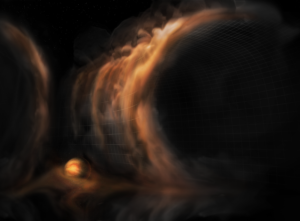I think that you are referring to the computer simulation results that were done a few years ago which…
Select :
asteroid collisionasteroidsastronomical distance scalesatomsbig bangblack holesbright lights in the skybrown dwarfcareerscelestial eventschecker cabscometsconstellationscosmic distancescosmic microwave backgroundcosmic rayscosmologydark energydark matterdwarf planeteartheclipseeclipticeducationexoplanetsexpansion of the universegalaxiesgeneral relativitygravitational lensgravity wavesGreat Red SpotHoaxesHubble Space Telescope (HST)Interferometerinterferometryinterstellar moleculesionosphereJupitermagnetarsmarsmeteorsMH370milky wayMilky Way Galaxymoleculesmoonmoonsneutron starneutron starsNibirunight skyparallaxphysicsplanetsplutoproperties of lightPtolemypulsarsquasarsradar astronomyRadio Astronomyradio frequency interferenceradio interferometersradio recombination line emissionRadio TelescopeSatellite DishSchwarzschild Radiusscientific methodsearch for extraterrestrial intelligenceSETIsolar systemspace probesspacecraftstar formationstarssunsupernovasupernova remnantssupernovaetelescopestime dilationTrans Neptunian Objectstwin paradoxunexplained celestial observationsVenusVery Large ArrayVery Long Baseline Array (VLBA)Voyager 1weather

Can Pressure Variations Associated with Acoustic Solar Core Ringing Change the Rate of Fusion in the Sun?
Question: I read that radioactive decay rates for some elements show cyclic variations, possibly due to varying solar neutrino…
How is Antenna Efficiency Defined and How Can One Use Measurements of the Sun to Calculate It?
Question: I am an undergraduate Physics student carry out a research to determine the brightness temperature of the sun…
How Was Astronomy Used to Create the Mayan Calendar?
Question: How was astronomy used to create the Mayan Calendar? — Joe Answer: I think that the most comprehensive…
When Will the Sun Expand and Engulf the Earth?
Question: When will the temperature be unbearable here on Earth due to the Sun’s increasing size? — Charlie Answer:…
Radio Caustics and Cusps in the Earth’s Ionosphere
Question: Hi! My question is about ionospheric caustics (IC). In dynamic spectra of several radio telescopes during daily solar…





